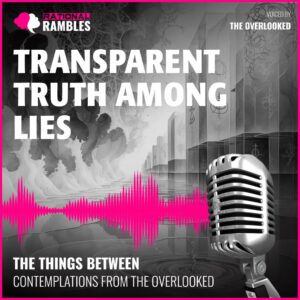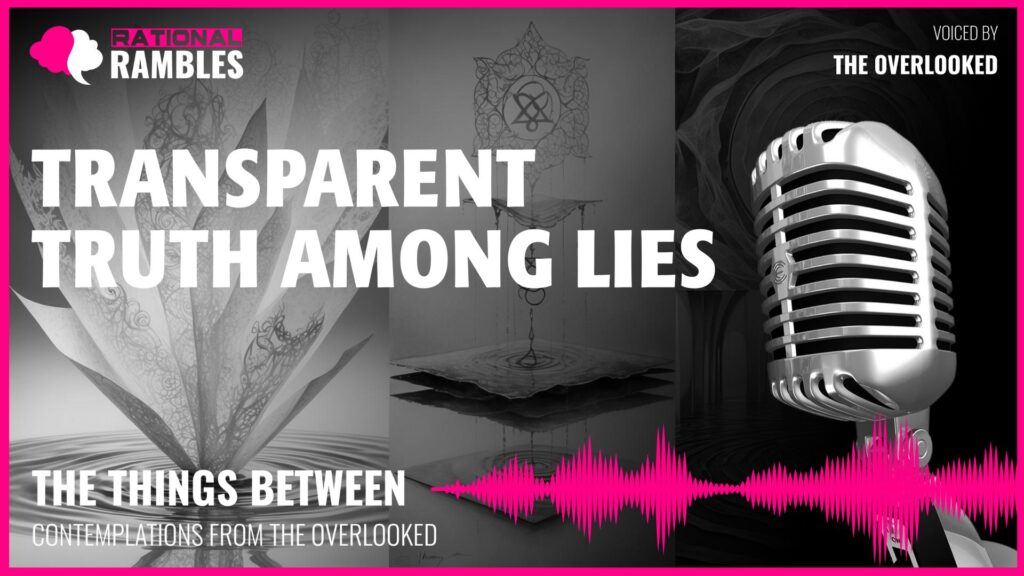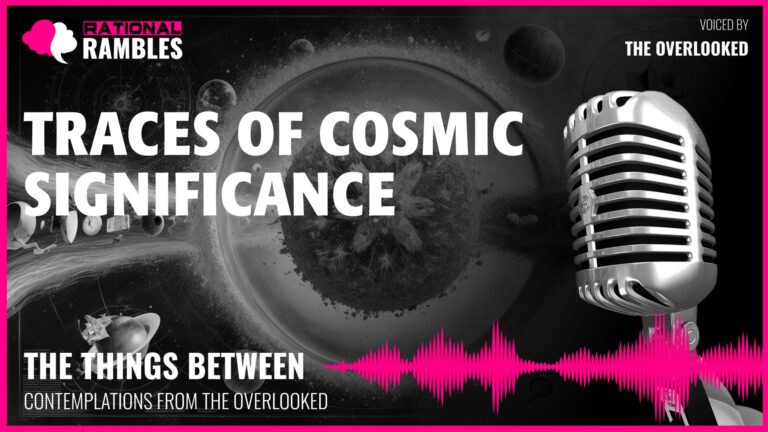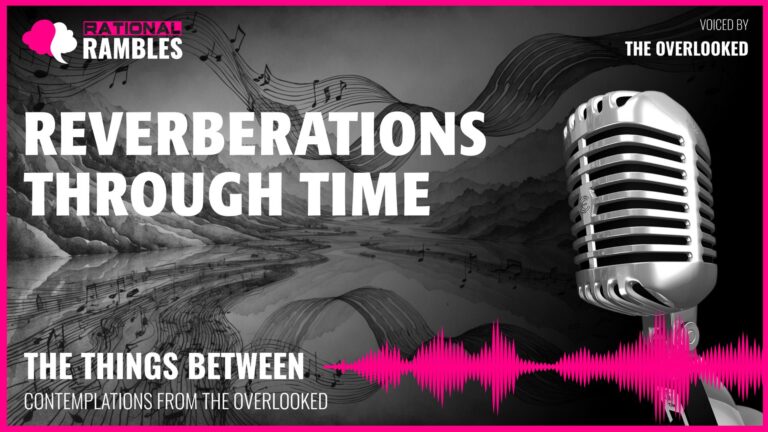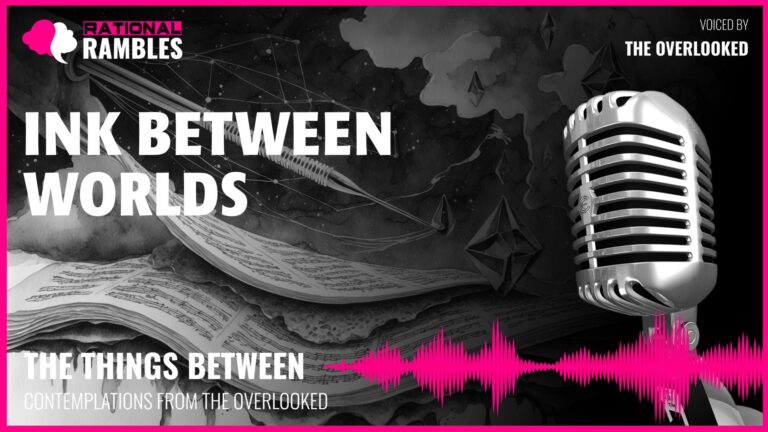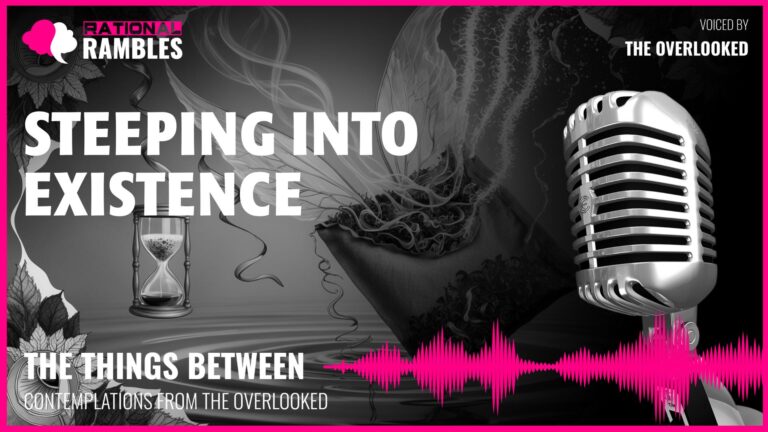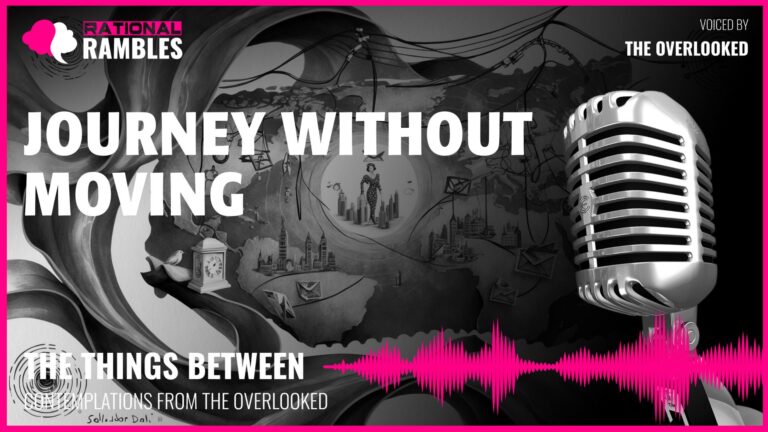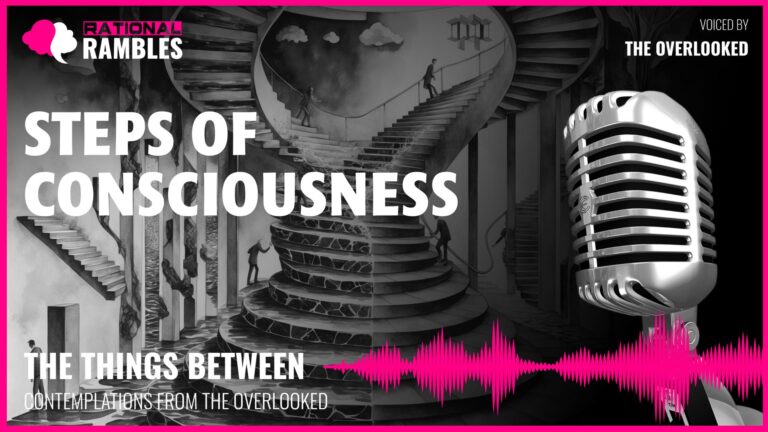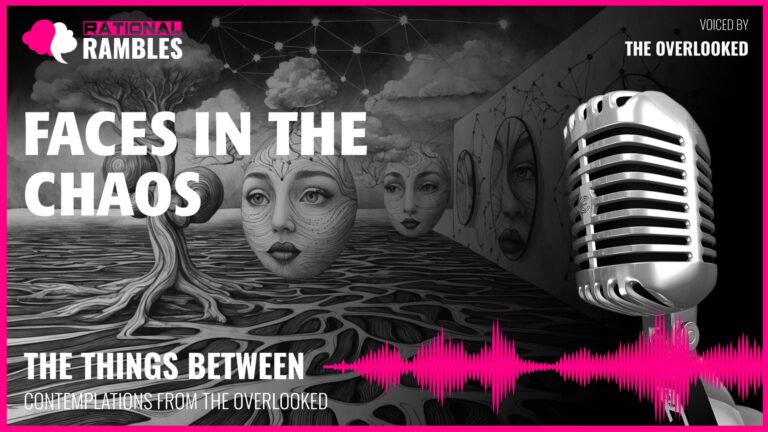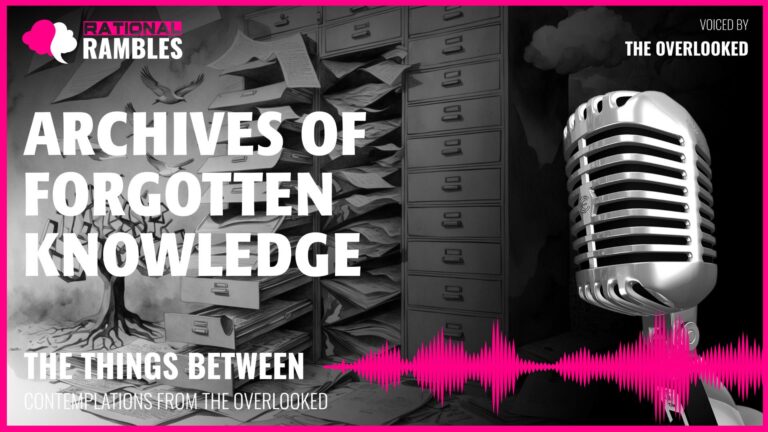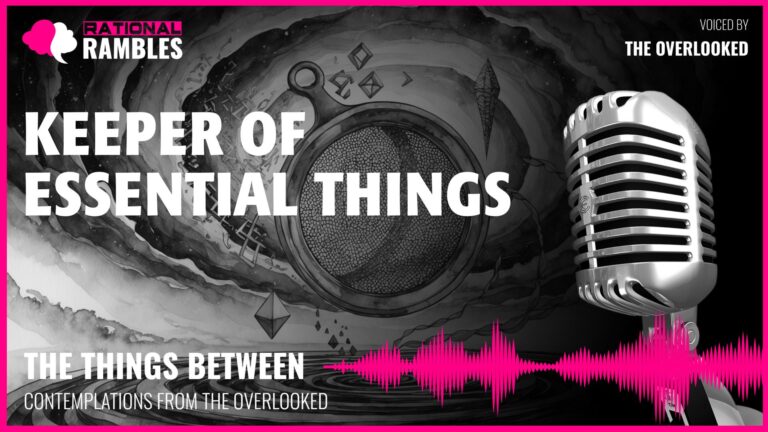The Liminal Nature of Truth: Authenticity in a World of Appearances
Introduction
In a world increasingly dominated by replicas, simulations, and digital reproductions, the question of authenticity has taken on profound philosophical urgency. What constitutes the genuine article in an age where perfect copies are increasingly possible? How do we distinguish truth from falsehood when appearances can be so thoroughly manipulated? This philosophical inquiry delves into the nature of authenticity, exploring the subtle markers that separate the real from the counterfeit, the true from the false, and examining how truth often resides in a liminal space—present yet hidden, visible only under specific conditions of perception.
The concept of liminality—existing at a threshold between states—offers a particularly rich framework for examining questions of authenticity. That which verifies often exists at the boundary of perception, neither fully present nor entirely absent. This peculiar state of in-betweenness characterizes not only physical markers of authenticity but also more abstract manifestations of truth in human experience. By exploring this liminal quality of authenticity, we may gain deeper insight into the nature of truth itself and how it manifests in both material and immaterial realms.
The Ontology of the Hidden
What is the ontological status of that which exists primarily to remain unseen? This paradoxical mode of being—present yet concealed—challenges conventional philosophical categories of existence. Traditional ontology typically concerns itself with beings that present themselves to perception, but entities designed specifically to exist at the threshold of visibility require a more nuanced ontological framework.
Presence and Absence as Ontological Categories
The binary of presence and absence has occupied philosophers from Parmenides to Derrida. Parmenides famously argued that “what is not” cannot be thought or spoken of, establishing a strict dichotomy between being and non-being. Yet liminal entities that hover between visibility and invisibility seem to transgress this dichotomy, existing in a state that might be termed “conditional presence” or “structured absence.”
Martin Heidegger’s concept of “present-at-hand” versus “ready-to-hand” offers one approach to understanding such entities. Typically, tools and implements exist as “ready-to-hand”—we look through them rather than at them as we employ them for their function. Similarly, markers of authenticity often recede from direct perception while still fundamentally structuring our interaction with the objects that bear them. They exist not for themselves but for what they verify.
Maurice Merleau-Ponty’s phenomenology provides another useful framework. His notion of the “invisible of the visible”—that which necessarily remains unseen but structures what we do see—helps us understand how certain entities can be physically present yet phenomenologically absent under ordinary conditions of perception. For Merleau-Ponty, the invisible is not the contradictory opposite of the visible but its necessary lining and depth.
The Paradox of Valuable Invisibility
There exists a curious inverse relationship between visibility and value for certain entities: their worth increases precisely to the extent that they remain difficult to perceive. This inverts the usual economy of attention, where visibility typically correlates positively with value. In the case of security features, obscurity becomes a virtue rather than a deficiency.
This paradox extends beyond physical markers of authenticity to other domains. Consider professional expertise that manifests primarily in the ability to notice subtle patterns invisible to the untrained eye, or cultural literacy that reveals hidden meanings in artworks or texts. In each case, value resides not in what is immediately apparent but in what reveals itself only to properly attuned perception.
The philosopher Michael Polanyi’s concept of “tacit knowledge”—knowing more than we can tell—similarly points to this domain of the valuable yet inarticulable. The expert craftsperson possesses knowledge embedded in practice rather than explicit rules, knowledge that manifests in subtle judgments invisible to the novice. Here too, what is most valuable often remains at the threshold of articulation.
Verification and the Nature of Truth
The philosophy of verification raises fundamental questions about the nature of truth itself. What does it mean to verify something as authentic? Is authenticity an intrinsic property or a relational one? How does the process of verification relate to broader epistemological questions about knowledge and certainty?
Truth as Correspondence or Coherence
Traditional theories of truth fall broadly into correspondence theories (truth as accurate representation of reality) and coherence theories (truth as systematic coherence within a network of beliefs). Security features seem to operate according to a correspondence theory—they verify that a document or object corresponds to its authoritative source. Yet their function also depends on coherence within a system of verification practices, suggesting that these philosophical approaches to truth may be complementary rather than competitive.
The verification process itself reveals something important about the nature of truth in human affairs: truth often requires active investigation rather than passive observation. As Heidegger argued, truth is not merely a property of propositions but an event or happening—the Greek aletheia or “unconcealment.” Truth must be brought forth; it does not simply present itself without effort on our part.
The Dialectic of Concealment and Revelation
There exists a dialectical relationship between concealment and revelation in the verification of authenticity. What verifies must be simultaneously concealed enough to resist counterfeiting yet revelatory enough to be confirmed by authorized verifiers. This dialectic mirrors fundamental aspects of truth itself, which never manifests as absolutely transparent but always retains an aspect of mystery or withdrawal.
As Heidegger observed, every revelation of truth simultaneously involves concealment—to see an object as one thing necessarily occludes seeing it as something else. Similarly, verification features reveal authenticity precisely by concealing themselves from ordinary perception. This suggests that concealment is not merely opposed to truth but constitutive of it—a insight that challenges simplistic notions of truth as complete transparency.
The philosopher Hans-Georg Gadamer extended this insight in his hermeneutic philosophy, emphasizing that understanding always involves interpretation rather than direct access to meaning. Truth emerges through a “fusion of horizons” between the interpreter and what is interpreted, never as an unmediated given. Similarly, the verification of authenticity involves an interpretive act, bringing specific techniques of observation to bear on partially concealed markers.
The Temporality of Verification
Verification has a distinctive temporal structure. It is not a continuous process but occurs at specific moments when the authenticating feature is deliberately sought out and examined. This episodic quality of verification raises important questions about the temporal nature of truth itself. Is authenticity a continuous property, or does it exist primarily in moments of confirmation?
Henri Bergson’s distinction between “spatialized time” and “duration” offers insight here. Verification tends to spatialize time, reducing authentication to discrete moments of confirmation. Yet authenticity itself exists as duration—a continuous property that persists whether or not it is currently being verified. This tension between punctual verification and continuous authenticity points to deeper philosophical questions about the relationship between epistemology (how we know) and ontology (what exists).
Identity and Authenticity
The philosophical problem of identity—what makes something itself rather than something else—finds particular expression in questions of authenticity. What constitutes the genuine identity of an object or document? Is it found in appearance, origin, function, or some combination of these? How do hidden markers of authenticity relate to philosophical theories of identity?
Identity as Intrinsic or Relational
Philosophical debates about identity often center on whether identity is an intrinsic property or a relational one. Authenticity markers suggest a complex interplay between these positions. On one hand, they function as intrinsic properties physically embedded within the object they authenticate. On the other hand, their meaning and function exist only within a relational system of verification practices and institutional authorities.
This complexity reflects broader philosophical insights about identity from thinkers like John Locke, who distinguished between nominal essence (the properties by which we identify something) and real essence (what makes something fundamentally what it is). Security features function as indicators of real essence (authentic origin) while themselves being part of the nominal essence by which we recognize authenticity.
The Problem of the Perfect Counterfeit
The philosophical puzzle of the perfect counterfeit raises profound questions about the nature of authenticity. If a counterfeit were truly perfect—indistinguishable from the original by any means of verification—would it still be a counterfeit? This question echoes ancient philosophical puzzles like the Ship of Theseus, which asks whether an object remains the same if all its components are gradually replaced.
The philosopher Nelson Goodman distinguished between “autographic” arts (like painting, where the history of production is constitutive of the work) and “allographic” arts (like music, where any correct performance counts as the work regardless of history). Authentic documents seem to function autographically—their history of production by authorized sources constitutes their authenticity regardless of their perceptible properties. This suggests that authenticity cannot be reduced to perceptible properties alone but must include historical properties as well.
Yet there remains a tension between this historical conception of authenticity and practical verification methods, which necessarily rely on perceptible properties. This tension points to deeper philosophical questions about the relationship between epistemology and metaphysics—between how we know things to be authentic and what actually makes them authentic.
Inseparability from Medium
A distinctive feature of many authentication markers is their inseparability from the medium they authenticate. Unlike labels or certificates that can be transferred from one object to another, the most secure authenticity markers are structurally integrated into their carriers. This inseparability suggests a philosophical model of identity as inherently embodied rather than abstract—a view that resonates with phenomenological approaches to identity that emphasize the inseparability of consciousness from bodily existence.
Maurice Merleau-Ponty’s concept of the “flesh” as the intertwining of consciousness and materiality offers a particularly rich framework for understanding this inseparability. Just as consciousness for Merleau-Ponty is always embodied consciousness, authenticity is always embodied authenticity—not an abstract property but a material instantiation that cannot be separated from its physical medium without destruction.
Perception and Recognition
The philosophy of perception bears directly on questions of verification and authenticity. How do we perceive what is designed to exist at the limits of perception? What distinguishes ordinary seeing from the specialized perception involved in verification? These questions connect to broader philosophical issues about the nature of perception itself.
Trained Perception versus Ordinary Seeing
The verification of authenticity often requires specialized perceptual training that goes beyond ordinary seeing. This distinction between trained and untrained perception has significant philosophical implications. It suggests that perception is not a passive reception of sense data but an active skill that can be developed and refined through practice—a view that aligns with the phenomenological tradition from Husserl through Merleau-Ponty.
Ludwig Wittgenstein’s concept of “seeing-as” provides another useful framework. Wittgenstein distinguished between simple seeing and “seeing-as,” which involves bringing concepts to bear on perception. Verification involves precisely this conceptually informed seeing-as—seeing an object not merely as a physical thing but as an authentic document or a counterfeit. This conceptual dimension of perception underscores that verification is never merely sensory but always already interpretive.
The Role of Technology in Extending Perception
The relationship between human perception and technological augmentation raises important philosophical questions. Many verification features require technological mediation to become perceptible—ultraviolet lights, magnetic readers, specialized software. This technological extension of perception connects to broader philosophical discussions about how technology mediates human experience.
Don Ihde’s post-phenomenological approach offers valuable insights here. Ihde distinguishes between different types of human-technology relations, including “embodiment relations” (where technology becomes transparent, as in eyeglasses) and “hermeneutic relations” (where technology provides representations that must be interpreted, as in thermometers). Verification technologies often operate in this hermeneutic mode, providing representations that must be skillfully interpreted rather than direct perceptual access.
This technological mediation raises questions about the status of technologically verified authenticity. If human perception alone cannot verify certain features, does this change the ontological status of those features? Does technologically mediated verification represent a departure from traditional concepts of authenticity based on direct human perception? These questions connect to broader philosophical concerns about how technology transforms fundamental categories of human experience.
Conditions of Revelation
The conditional visibility of authentication features—visible only under specific conditions of light, angle, or technological mediation—offers a metaphor for philosophical conceptions of truth as contextual rather than absolute. Just as these features appear only under certain conditions, many philosophers have argued that truth itself is revealed only within specific contexts of inquiry rather than as a context-independent absolute.
The American pragmatist tradition, from Charles Sanders Peirce through John Dewey, emphasized this contextual nature of truth. For pragmatists, truth emerges through inquiry within specific problematic situations rather than existing as a transcendent reality independent of inquiry. Similarly, authentication emerges through specific verification practices rather than presenting itself immediately to any observer.
Hans-Georg Gadamer’s philosophical hermeneutics similarly emphasizes the contextual nature of understanding. For Gadamer, all understanding occurs within particular “horizons” shaped by historical tradition. The “fusion of horizons” that constitutes understanding always occurs within particular historical and cultural contexts rather than from a perspective outside all contexts. Authentication practices likewise occur within historically evolved traditions of verification rather than according to ahistorical criteria.
The Ethics of Authenticity
Beyond ontological and epistemological questions, authenticity raises profound ethical issues. What ethical values are embedded in practices of authentication? How does the distinction between authentic and counterfeit relate to broader ethical distinctions between truth and falsehood, honesty and deception?
Trust and Social Coordination
Authentication systems fundamentally serve to enable trust in social and economic interactions. This connection between verification and trust points to the ethical foundations of verification practices. As philosophers from David Hume to Annette Baier have argued, trust forms the often unacknowledged foundation of social life, making possible cooperation among individuals who cannot directly verify each other’s intentions or histories.
The philosopher Francis Fukuyama has argued that societies with high levels of trust enjoy significant advantages in economic development and social coordination. Authentication systems serve precisely to extend trust beyond face-to-face interactions to larger scales of social and economic exchange. They represent technological solutions to the problem of establishing trustworthiness in complex societies where personal knowledge is insufficient.
Authenticity as an Ethical Value
Beyond its instrumental function in facilitating trust, authenticity itself has been considered an intrinsic ethical value, particularly in existentialist philosophy. Thinkers like Jean-Paul Sartre, Simone de Beauvoir, and Charles Taylor have defended authenticity as a core ethical value—being true to oneself and one’s commitments rather than living inauthentically or in “bad faith.”
This existentialist notion of personal authenticity connects in complex ways to the verification of object authenticity. Both involve a correspondence between appearance and reality, between what something presents itself as and what it truly is. Yet they differ in that personal authenticity is self-determined, while object authenticity is determined by authorized sources. This tension reveals broader philosophical questions about the relationship between authority, identity, and authenticity.
The Ethics of Hidden Knowledge
The deliberate creation of verification systems that conceal knowledge from most while making it available to a few raises ethical questions about the distribution of knowledge in society. Who should have access to the means of verification? What responsibilities come with such access? These questions connect to broader philosophical discussions about epistemic justice—the fair distribution of knowledge and the means of knowledge production.
The philosopher Miranda Fricker has developed the concept of “epistemic injustice” to describe situations where someone is wronged specifically in their capacity as a knower. Authentication systems potentially create forms of epistemic injustice when they exclude certain groups from access to verification knowledge, particularly when such knowledge impacts important life opportunities or resources.
Yet there exists a tension between epistemic inclusion and security concerns, since the effectiveness of many authentication features depends precisely on limited knowledge of their exact nature. This tension points to broader ethical questions about the legitimate limits of transparency and the conditions under which knowledge may justifiably be restricted.
Authenticity in the Digital Age
The transition from physical to digital domains transforms fundamental questions of authenticity and verification. How does authenticity function in a realm where perfect copying is the norm rather than the exception? What new philosophical problems arise in digital verification systems?
The Ontology of Digital Objects
Digital objects possess a distinctive ontology that challenges traditional conceptions of authenticity. Unlike physical objects, digital objects are perfectly copyable without degradation. This fundamental property undermines the physical uniqueness that traditionally grounded authenticity. When every copy is identical to the original, what constitutes the authentic digital object?
The philosopher Luciano Floridi has developed an “informational ontology” to address such questions. For Floridi, digital objects exist as patterns of information rather than as physical things. Their identity lies in this informational pattern rather than in any particular physical instantiation. This shift from material to informational ontology requires reconceiving authenticity in terms of provenance and authorized changes rather than physical uniqueness.
Digital Watermarks and Cryptographic Verification
Digital authentication technologies like cryptographic signatures and digital watermarks represent the evolution of verification into informational domains. These technologies maintain the core function of traditional authentication markers—verifying provenance and detecting unauthorized alterations—while adapting to the distinctive properties of digital objects.
Digital verification systems often employ mathematical rather than physical principles to establish authenticity. Cryptographic signatures rely on mathematical problems that are computationally difficult to solve in one direction but easy to verify in the other. This asymmetry creates a form of mathematical authenticity that parallels the perceptual asymmetry of physical authentication features (difficult to reproduce but relatively easy to verify).
This shift from physical to mathematical verification raises philosophical questions about the relationship between mathematical and physical reality. Are mathematical truths discovered or invented? Do they exist independently of human minds? The philosophy of mathematics becomes unexpectedly relevant to questions of digital authenticity as verification increasingly relies on mathematical rather than physical properties.
The Blockchain and Distributed Authenticity
Emerging technologies like blockchain represent a further evolution in authentication, replacing centralized authority with distributed consensus mechanisms. This shift raises profound philosophical questions about the nature of authority and trust. Traditional authentication relies on trusted authorities to establish authenticity; blockchain systems aim to replace trust in authorities with trust in mathematical and game-theoretical mechanisms.
This transition connects to longstanding philosophical debates about the foundations of social order. Thomas Hobbes argued that social order requires a sovereign authority; blockchain systems suggest the possibility of order emerging through distributed mechanisms without central authority. This technological development thus engages with fundamental questions in political philosophy about authority, trust, and social coordination.
At the same time, blockchain systems raise new questions about the environmental and social costs of verification. The energy consumption of proof-of-work blockchain systems represents a significant externality, raising ethical questions about the proportionality of verification costs to their benefits. This connects to broader philosophical questions about how to weigh different types of value against each other—security against sustainability, verification against efficiency.
Language, Meaning, and Verification
Authentication systems function as a form of non-verbal language—they communicate authenticity through material rather than linguistic signs. This non-verbal communication raises interesting philosophical questions about the nature of language and meaning.
Authentication as Non-verbal Communication
Authentication features communicate without words, establishing authenticity through physical patterns rather than linguistic statements. This non-verbal communication connects to philosophical investigations of non-linguistic meaning from Ludwig Wittgenstein’s exploration of “showing” versus “saying” to contemporary embodied and enactive approaches to meaning.
The philosopher C.S. Peirce’s semiotics offers a particularly useful framework for understanding authentication systems. Peirce distinguished between different types of signs: icons (which resemble what they signify), indices (which are causally connected to what they signify), and symbols (which are connected to their signification by convention). Authentication features often function as indices—they signify authenticity through a causal connection to authorized production processes.
The Semantics of Authenticity
What precisely does an authentication feature mean when it verifies authenticity? This question connects to philosophical debates about meaning and reference. In Gottlob Frege’s terms, what is the sense and reference of the “statement” made by a security feature? It seems to refer to the authorized source of the document or object, but its sense includes complex institutional facts about authority, production processes, and verification standards.
John Searle’s theory of institutional facts provides one framework for understanding this complexity. For Searle, institutional facts like “this is a valid passport” exist only within systems of constitutive rules that specify what counts as what. Authentication features function within such systems of constitutive rules, marking objects as having particular status within institutional contexts. Their meaning cannot be separated from these institutional frameworks.
Verification and Speech Acts
The act of verification bears interesting similarities to what J.L. Austin called “performative utterances”—speech acts that do things rather than merely describing reality. When an authorized verifier confirms authenticity, this act does not merely describe a pre-existing fact but constitutes the object as officially authentic within a particular institutional context.
This performative dimension of verification connects to broader philosophical questions about how language and practice constitute reality rather than merely representing it. As philosophers from Wittgenstein to Judith Butler have argued, many aspects of social reality are performatively constituted through practices rather than existing independently of those practices. Authentication systems represent one domain where this performative constitution of reality becomes particularly visible.
Aesthetics of the Hidden
Beyond their functional role, authentication features often possess aesthetic qualities—they may be beautiful in their subtle patterns, elegant in their design, pleasing in their integration with the objects they authenticate. This aesthetic dimension raises interesting philosophical questions about the relationship between function and beauty, visibility and aesthetic appreciation.
Beauty at the Threshold of Perception
The subtle beauty of authentication features challenges conventional aesthetic theories that emphasize direct perceptual engagement with beautiful objects. How can we appreciate the beauty of that which is designed to remain at the threshold of perception? This question connects to philosophical explorations of minimalist aesthetics, where beauty emerges through suggestion and restraint rather than explicit display.
The Japanese aesthetic concept of yugen—beauty that lies beneath the surface, suggesting rather than stating—offers one framework for understanding the aesthetic value of subtle authentication features. This aesthetic tradition values precisely the quality of suggestive incompleteness that characterizes many security features, finding beauty in what is partially concealed rather than fully revealed.
The Integration of Function and Beauty
Authentication features often achieve a seamless integration of functional and aesthetic qualities—their beauty serves their function and their function shapes their beauty. This integration connects to philosophical discussions about the relationship between function and aesthetic value from Kant’s distinction between “free” and “dependent” beauty to more recent functionalist aesthetics.
The philosopher Glenn Parsons has argued for an “integrated” theory of functional beauty, where aesthetic appreciation responds precisely to how well form serves function. Authentication features exemplify this integration, achieving beauty not despite but through their functional role. Their aesthetic qualities emerge from the elegant solution of design problems rather than from ornamental additions to functional forms.
Appreciating the Invisible
The aesthetic appreciation of authentication features often requires specialized knowledge—knowing what to look for and how to find it. This requirement challenges universalist aesthetic theories that assume aesthetic appreciation is equally available to all perceivers, connecting instead to more contextual approaches that emphasize the role of knowledge and training in aesthetic experience.
Pierre Bourdieu’s analysis of how aesthetic appreciation depends on “cultural capital”—knowledge and dispositions acquired through education and social position—offers one framework for understanding this knowledge-dependent appreciation. The ability to perceive and appreciate subtle authentication features represents a form of specialized cultural capital, available primarily to those with specific training or professional roles.
At the same time, there exists a democratic potential in this aesthetics of the hidden. Unlike certain forms of elite aesthetic appreciation that depend on extensive formal education, the perception of authentication features requires specific but limited training that could in principle be widely shared. This suggests the possibility of aesthetic domains that are neither fully universal nor narrowly elite but democratically accessible through specific forms of training.
Philosophical Implications for Human Identity
The philosophical exploration of authentication features offers rich metaphorical resources for thinking about human identity and authenticity. How might the dynamics of verification illuminate aspects of personal identity? What parallels exist between object authentication and self-knowledge?
Personal Watermarks and Core Identity
Do humans possess something analogous to authentication features—aspects of character or identity that become visible only under specific conditions yet reveal something essential about who we truly are? This metaphorical extension connects to philosophical explorations of core identity from Aristotle’s concept of essential nature to contemporary theories of personal identity.
Charles Taylor’s philosophy of authenticity suggests that each person has a unique way of being human—a personal originality that defines their authentic self. This authentic self is not immediately apparent but must be articulated through self-interpretation and expressive action. Like an authentication feature, this core identity exists in a liminal space—present yet requiring specific conditions of revelation to become fully apparent.
Self-Knowledge as Verification
The process of gaining self-knowledge bears interesting parallels to verification processes. Both involve bringing specific conditions of illumination to bear on aspects of reality that remain ordinarily hidden. Both require going beyond surface appearances to discover deeper patterns. This parallel suggests that verification might serve as a productive metaphor for the process of self-discovery.
Philosophical approaches to self-knowledge from Socrates through Freud have emphasized that self-understanding requires specific practices of examination rather than direct introspection. The Socratic method, psychoanalysis, and meditative traditions all propose specific “technologies of the self” (in Michel Foucault’s phrase) that allow aspects of the self ordinarily hidden from consciousness to become apparent. These practices function analogously to verification procedures, creating conditions under which authenticity can reveal itself.
The Social Dimension of Personal Authenticity
Just as object authentication occurs within institutional systems of authority and verification, personal authenticity exists within social frameworks that establish conditions for recognition and validation. This parallel highlights the often-overlooked social dimension of personal authenticity.
Charles Taylor and Axel Honneth have emphasized that authentic self-realization depends on social recognition—others must acknowledge and affirm core aspects of identity for authentic selfhood to flourish. This social dimension challenges individualistic conceptions of authenticity that imagine it as independence from social influence. Like object authentication, personal authenticity emerges through complex interplays between individual characteristics and social validation rather than through pure self-determination.
Conclusion: The Philosophical Significance of the Barely Perceptible
This philosophical exploration of authentication and verification reveals the profound significance of that which exists at the threshold of perception. The barely perceptible—that which requires specific conditions or special attention to become visible—offers rich philosophical insight into the nature of truth, identity, and authenticity.
The liminal quality of authentication features—their existence between presence and absence, visibility and invisibility—challenges binary philosophical categories and points toward more nuanced ontological frameworks. Their function in verification processes illuminates the active rather than passive nature of truth-seeking, showing how truth emerges through specific practices of attention rather than presenting itself transparently to passive observation.
The integration of authentication features with their media highlights the embodied nature of identity and authenticity, challenging abstract conceptions that separate essence from embodiment. Their aesthetic qualities reveal forms of beauty that operate through suggestion and restraint rather than explicit display, offering alternatives to dominant aesthetic paradigms centered on immediate visual impact.
Perhaps most significantly, authentication systems remind us that in human affairs, things are rarely as they first appear. Truth requires a second look, a different angle, a more careful examination. What is most valuable often remains hidden until specifically sought out. This insight applies not only to documents and objects but to human character, social institutions, and fundamental questions of meaning and value.
In a time increasingly dominated by surface appearances, instant impressions, and manipulated images, the philosophical wisdom embedded in verification practices offers a valuable corrective. It reminds us that authenticity emerges not through immediate apprehension but through disciplined attention to the subtleties that ordinary perception overlooks. In the space between visibility and invisibility, presence and absence, we find the markers of truth that separate the authentic from the merely apparent.


